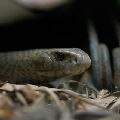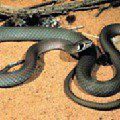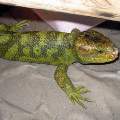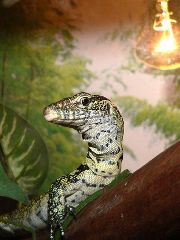
Brown reticulated snake
The brown reticulated snake (Demansia textilis) belongs to the family of snakes that live in Australia. These snakes are not afraid of drought, characteristic of its hot climate. The standard size of a brown reticulated snake is 1,5-2 meters, but larger individuals are also found. And, of course, Demansia textilis are poisonous, as are all asps. Their brown color is partly camouflage – such a snake is not immediately noticeable in the brownish Australian sands, it is no coincidence that it belongs to the Demancia sand snake genus. Its activity is manifested mainly in the daytime, when the snake hunts for small mammals. In comfortable conditions for themselves, such a snake can live from 10 to 30 years. It has all the properties typical of aspids – two fixed poisonous fangs in front, a smooth body throughout without noticeable narrowing and thickening, neurotoxic poison.
Contents
Classification
Kingdom: Animals
Type: Chord
Subtype: Vertebrates
Class: Reptiles
Order: Scaly
Suborder: Snakes
Family: Aspides, Elapidae
Genus: Demansia, Demansia, brown snakes, sand snakes
Species: Brown reticulated snake, Demansia textilis from lat. textile – fabric, something woven from fibers (meaning the mesh color of a snake),
Brown snake (eng.)
Appearance
 This snake from the aspid family is undeservedly called ordinary. In fact, its commonness is explained by perhaps not too remarkable appearance. Adult reticulated snakes have a uniform brownish-gray color, and young ones are distinguished by bright transverse rings on the body. The rounded head is connected to the body of these snakes into a single whole, without thinning at the junction. And the body of the brown reticulated snake, I must say, is quite slender. The locals even gave her the nickname “whip”. Large, armor-like shields are located all over the head of the demansia, and the same large pattern is on the ventral part of the body. The name of the reticulated brown snake deserved precisely because of the external impression that its epidermis makes – it seems that it is all painted with a reticulated pattern. In fact, this effect is produced by snake skin shields, as if delimited from each other by a thin dark border.
This snake from the aspid family is undeservedly called ordinary. In fact, its commonness is explained by perhaps not too remarkable appearance. Adult reticulated snakes have a uniform brownish-gray color, and young ones are distinguished by bright transverse rings on the body. The rounded head is connected to the body of these snakes into a single whole, without thinning at the junction. And the body of the brown reticulated snake, I must say, is quite slender. The locals even gave her the nickname “whip”. Large, armor-like shields are located all over the head of the demansia, and the same large pattern is on the ventral part of the body. The name of the reticulated brown snake deserved precisely because of the external impression that its epidermis makes – it seems that it is all painted with a reticulated pattern. In fact, this effect is produced by snake skin shields, as if delimited from each other by a thin dark border.
The jaws of Demansia textilis are arranged primitively, like those of the entire family of asps: in the front at the top there are large fangs with a venomous canal – the same ones, the exposure of which is a sign of extreme aggression. And behind them on the upper jaw there are from 7 to 15 fixed, in contrast to the family of vipers, small teeth. By the way, the number of fangs is two, historically justified by the fact that the brown reticulated snake, like all asps, is capable of changing poisonous teeth. In addition, like all other snakes, she sheds twice a year.
From the outside, this thin and slender reptile is easily mistaken for a snake, with which asps are often confused. And if we take into account that among snakes there are many poisonous species, then only the trained eye of a specialist is sometimes able to distinguish between representatives of these genera.
Distribution and habitation
The habitat of the brown reticulated snake is limited to mainland Australia, especially Demansia textilis is common in its Eastern part. They feel quite comfortable in hot and dry areas. Therefore, sometimes snakes of this species are called Australian. At the same time, no brown reticulated snakes were found on the island of Tasmania, an Australian state separated from the mainland by a strait. But other snakes of the genus Demansia managed to penetrate New Guinea and some other islands. Particularly large representatives of the species Demansia textilis, reaching a length of over two meters, have been recorded in Western Victoria.
Behavior and lifestyle
 The brown reticulated snake, like other asps, is considered a dangerous creature – its venom has, although not the fastest, but in some cases a deadly effect on humans. Once in the body, it inhibits the functioning of the nervous system, that is, it has a neurotoxic effect that primarily affects the respiratory center. The first sign of intoxication is shortness of breath, which eventually stops completely, which leads to death. However, this snake is dangerous not so much with its poison, from which they die not so often, but with their behavior. Scientists noted the special aggressiveness of demancias, their constant readiness for an attack. In addition, the bite of a brown reticulated snake is very painful, because during it it is forced to clench its jaws strongly in order to bite through the victim. This snake often goes hunting during the day, it is not afraid of the Australian heat, but sometimes it is able to lie in wait for the victim at dusk, that is, it cannot be called strictly diurnal.
The brown reticulated snake, like other asps, is considered a dangerous creature – its venom has, although not the fastest, but in some cases a deadly effect on humans. Once in the body, it inhibits the functioning of the nervous system, that is, it has a neurotoxic effect that primarily affects the respiratory center. The first sign of intoxication is shortness of breath, which eventually stops completely, which leads to death. However, this snake is dangerous not so much with its poison, from which they die not so often, but with their behavior. Scientists noted the special aggressiveness of demancias, their constant readiness for an attack. In addition, the bite of a brown reticulated snake is very painful, because during it it is forced to clench its jaws strongly in order to bite through the victim. This snake often goes hunting during the day, it is not afraid of the Australian heat, but sometimes it is able to lie in wait for the victim at dusk, that is, it cannot be called strictly diurnal.
Food
The main food of brown reticulated snakes are small animals – mice and rats, gaping birds and lizards, as well as smaller representatives of the snake suborder. Demansia textilis can go without water for a long time; to maintain the water balance, they have enough juices obtained along with live food.
Reproduction
Like most representatives of the suborder, brown reticulated snakes are oviparous. The number of eggs laid by the female is 15-30 pieces, and the waiting time for young individuals is 2 months. Snake eggs have nothing to do with the hard-shell bird eggs we are used to. They are covered with a soft shell that feels like skin to the touch. The brown reticulated snake lays them in a specially prepared place for this – a recess dug for it in a suitable substrate, most often in sand, where the temperature is favorable for the incubation of offspring. The further fate of the masonry is not of interest to the demansion.
Content
 Keeping Demansia textilis in captivity, like caring for any other venomous, and therefore dangerous, snake, must include certain precautions.
Keeping Demansia textilis in captivity, like caring for any other venomous, and therefore dangerous, snake, must include certain precautions.
According to the general rules, the diagonal terrarium for a brown reticulated snake should correspond to the length of its body, its walls should be thick and strong, especially the front glass. Experts recommend installing it on a special latch, which even a large and strong snake cannot move away.
Although Demansia textilis seems to be unpretentious in food, it is desirable to provide them with food as close to natural as possible, as well as the habitat. Modern terrariums are usually equipped with adjustable heating and lighting, allowing you to set the right conditions for unusual pets.
Brown snakes can be fed live or frozen food, such as mice. The main thing is to choose one option that your demancia will get used to and not change it.
But placing two individuals in one terrarium is not recommended because of their tendency to eat their own kind.
And yet, experienced herpetologists do not recommend keeping poisonous snakes at home. If you really want to look at the demansia so much, then the best place for this is a zoo or nursery. True, in nurseries such snakes are a rarity. And since people get data about their life from observations of reptiles in artificial conditions, the brown reticulated snake belongs to the little-studied snake species, in the scientific descriptions of which there are enough “white spots”.
Sources of
http://dic.academic.ru
http://ru.wikipedia.org
http://www.reptiliy.net
http://www.zooclub.ru/
http://big-snake.narod.ru
http://biotop-megapolis.ru
http://www.vitawater.ru/





